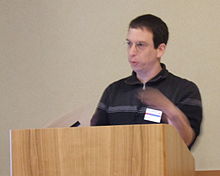Dan Boneh
Dan Boneh (* 1969 in Israel ) is an Israeli-American computer scientist and cryptologist.
Boneh received his PhD from Princeton University in 1996 with Richard J. Lipton (Studies in computational number theory with applications to cryptography). He is a professor at Stanford University . There he headed the group applied cryptography.
He works in the field of cryptology and computer security and developed new systems for Internet security (tcpcrypt), PwdHash for browsers and cryptographic watermarks. He dealt with the cryptanalysis of public key systems such as RSA , with the Decisional Diffie-Hellman problem and in 1995 with cryptanalysis with DNA computers (with Lipton).
Together with Matthew K. Franklin , he developed identity-based encryption mechanisms based on Weil pairing of elliptic curves (Franklin-Boneh method) in 2001 .
In 2003 he and David Brumley published a timing attack on OpenSSL and later on other web applications.
In 2009 he received the Gödel Prize with Franklin for Identity based encryption from the Weil pairing and in 2014 he received the ACM Infosys Award . He was a Packard and Sloan Research Fellow . He is co-founder of Voltage Security. In 2016 he was elected to the National Academy of Engineering and a Fellow of the Association for Computing Machinery .
Craig Gentry is one of his PhD students .
Web links
- Homepage in Stanford
- Voltage Security biography
- Literature by and about Dan Boneh in the WorldCat bibliographic database
Individual evidence
- ↑ Dan Boneh in the Mathematics Genealogy Project (English)
- ^ Cryptographic Protection of TCP Streams
- ↑ ID-based encryption (IBE). Introduced by Adi Shamir in 1984. They use identity information (such as name, email address) etc. of the user as a public key.
- ^ Dan Boneh, Matthew K. Franklin, Identity-Based Encryption from the Weil Pairing, Advances in Cryptology - Proceedings of CRYPTO 2001
- ↑ Boneh, Franklin, Identity based encryption from the Weil pairing, SIAM J. of Computing, Volume 32, 2003, pp. 586-615
- ^ Boneh, Brumley Remote timing attacks are practical , Proceedings of the 12th Usenix Security Symposium, 2003
- ^ A. Bortz, D. Boneh, P. Nandy Exposing private information by timing web applications , Proceedings of the 16th International Conference on World Wide Web, WWW 2007, ACM 2007, pp. 621-628
| personal data | |
|---|---|
| SURNAME | Boneh, Dan |
| BRIEF DESCRIPTION | Israeli-American computer scientist and cryptologist |
| DATE OF BIRTH | 1969 |
| PLACE OF BIRTH | Israel |
